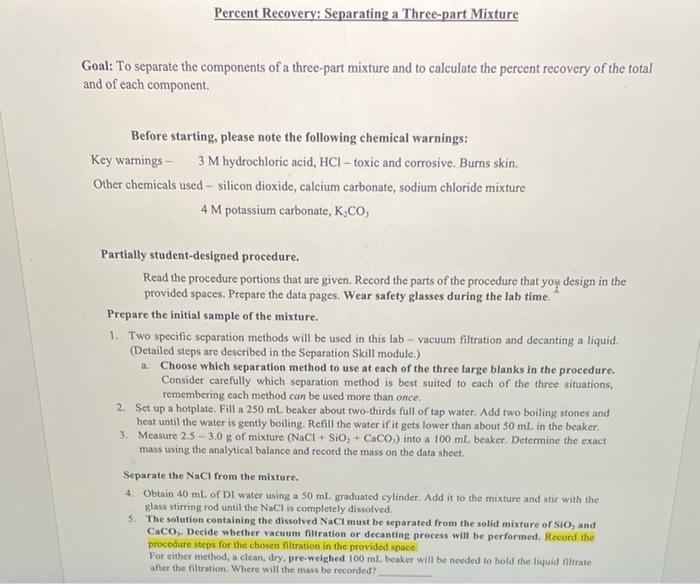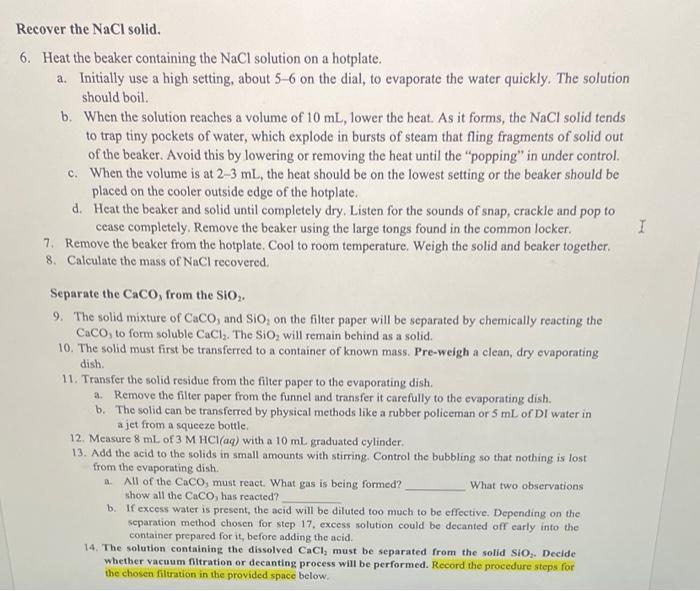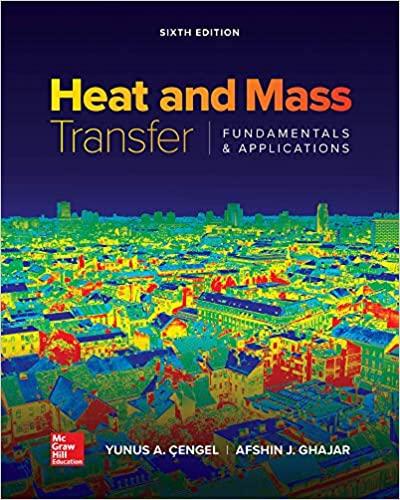Answered step by step
Verified Expert Solution
Question
1 Approved Answer
please answer all and explain thank you Percent Recovery: Separating a Three-part Mixture Goal: To separate the components of a three-part mixture and to calculate
please answer all and explain thank you 




Percent Recovery: Separating a Three-part Mixture Goal: To separate the components of a three-part mixture and to calculate the percent recovery of the total and of each component Before starting, please note the following chemical warnings: Key wamings - 3 M hydrochloric acid, HCI - toxic and corrosive. Burns skin. Other chemicals used - silicon dioxide, calcium carbonate, sodium chloride mixture 4 M potassium carbonate, K.CO, Partially student-designed procedure. Read the procedure portions that are given. Record the parts of the procedure that you design in the provided spaces. Prepare the data pages. Wear safety glasses during the lab time Prepare the initial sample of the mixture. 1. Two specific scparation methods will be used in this lab - vacuum filtration and decanting a liquid. (Detailed steps are described in the Separation Skill module.) Choose which separation method to use at each of the three large blanks in the procedure. Consider carefully which separation method is best suited to each of the three situations, remembering cach method can be used more than once. 2. Set up a hotplate. Fill a 250 ml beaker about two-thirds full of tap water. Add two boiling stones and heat until the water is gently boiling. Refill the water if it gets lower than about 50 mL in the beaker. 3. Measure 2.5 - 3.0 g of mixture (NaCl + Sio, + Caco) into a 100 ml beaker. Determine the exact mass using the analytical balance and record the mass on the data sheet. Separate the NaCl from the mixture. 4. Obtain 40 mL of DI water using a 50 ml. graduated cylinder. Add it to the mixture and stir with the glass stirring rod until the NaCl is completely dissolved. 5. The solution containing the dissolved NaCl must be separated from the solid mixture of Sio, and Caco. Decide whether vacuum filtration or decanting process will be performed. Record the procedure steps for the chosen filtration in the provided space Por either method, a clean, dry, pre-weighed 100 ml beaker will be needed to hold the liquid nitrate after the filtration. Where will the mass be recorded? Use this space to describe the step-by-step set-up and experimental procedure for the filtration you have chesen. Include enough detail to be useful during the lab time. Filtration Method Chosen: Step-by-step procedure: 1. Recover the NaCl solid, 6. Heat the beaker containing the NaCl solution on a hotplate. a. Initially use a high setting, about 5-6 on the dial, to evaporate the water quickly. The solution should boil. b. When the solution reaches a volume of 10 mL, lower the heat. As it forms, the NaCl solid tends to trap tiny pockets of water, which explode in bursts of steam that fling fragments of solid out of the beaker. Avoid this by lowering or removing the heat until the popping" in under control. c. When the volume is at 2-3 mL, the heat should be on the lowest setting or the beaker should be placed on the cooler outside edge of the hotplate. d. Heat the beaker and solid until completely dry, Listen for the sounds of snap, crackle and pop to cease completely. Remove the beaker using the large tongs found in the common locker 7. Remove the beaker from the hotplate. Cool to room temperature. Weigh the solid and beaker together 8. Calculate the mass of NaCl recovered. I Separate the Caco, from the SiO. 9. The solid mixture of Caco, and Sio, on the filter paper will be separated by chemically reacting the Caco, to form soluble CaCl. The Sio, will remain behind as a solid. 10. The solid must first be transferred to a container of known mass. Pre-weigh a clean, dry evaporating dish. 11. Transfer the solid residue from the filter paper to the evaporating dish. a. Remove the filter paper from the funnel and transfer it carefully to the evaporating dish. b. The solid can be transferred by physical methods like a rubber policeman or 5 mL of DI water in a jet from a squeeze bottle. 12. Measure 8 ml of 3 M HCl(aq) with a 10 ml graduated cylinder. 13. Add the acid to the solids in small amounts with stirring Control the bubbling so that nothing is lost from the evaporating dish. All of the Caco, must react. What gas is being formed? What two observations show all the Caco, has reacted? b. If excess water is present, the acid will be diluted too much to be effective. Depending on the separation method chosen for step 17, excess solution could be decanted off early into the container prepared for it, before adding the acid. 14. The solution containing the dissolved CaCl, must be separated from the solid Sio,. Decide whether vacuum filtration or decanting process will be performed. Record the procedure steps for the chosen filtration in the provided space below. Use this space to describe the step-by-step experimental procedure for either the decanting process or the gravity filtration, whichever you have chosen. Include enough detail to be useful during the lab time. Filtration Method Chosen: Step-by-step procedure: 1. Recover the SiO, solid. 15. Dry the Sio, by placing the evaporating dish on top of the 250 ml beaker of boiling water on the hotplate. The heat of the boiling water will transfer to the evaporating dish and cause the water clinging to the sand to evaporate a. The dry Sio, will "flow" smoothly, without any clumps. It may be necessary to stir the dry sand with a glass stirring rod to prevent it sticking to the dish. 16. Cool to the evaporating dish to room temperature. Wipe the bottom of the dish while it is still warm to ensure that all water is removed. 17. Weigh the dish and sand. Calculate the mass of recovered sand. Recover the Caco, solid 18. The solution containing the CaCl, must be heated until just beginning to boil. 19. Remove the beaker from the hotplate. Add 20 ml of 4 MX CO, in small amounts to the hot solution 20. Stir for 5 minutes after adding the K,CO,Cool the solution to room temperature. It should be really at room temperature, not still somewhat warm. 21. The precipitated Caco, must be separated from the solution. Decide whether vacuum filtration or decanting process will be performed. Record the procedure steps for the chosen filtration in the provided space Use this space to describe the step-by-step set-up and experimental procedure for the process you have chosen. Include enough detail to be useful during the lab time. Filtration Method Chosen: Step-by-step procedure 1 




Step by Step Solution
There are 3 Steps involved in it
Step: 1

Get Instant Access to Expert-Tailored Solutions
See step-by-step solutions with expert insights and AI powered tools for academic success
Step: 2

Step: 3

Ace Your Homework with AI
Get the answers you need in no time with our AI-driven, step-by-step assistance
Get Started


